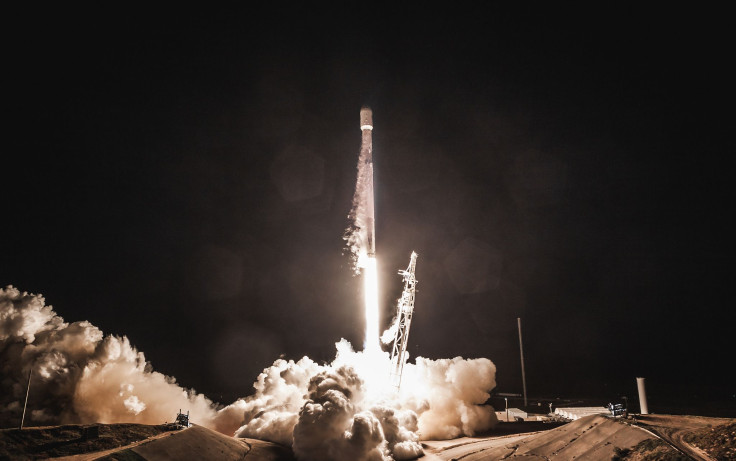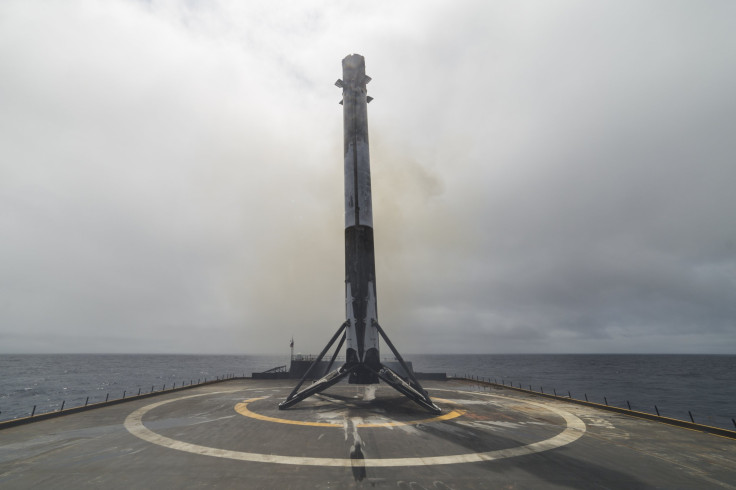SpaceX Falcon 9 Launch Live Stream: Watch Hispasat 30W-6 Satellite Take Off

UPDATE: 1:06 a.m. EST — The deployment of Falcon 9’s payload, a communications satellite for Spanish company Hispasat, was successful about 33 minutes after launch. SpaceX’s 50th launch of its trusted rocket went off without a hitch.
Successful deployment of Hispasat 30W-6 to a geostationary transfer orbit confirmed. pic.twitter.com/PHctrfzwKa
— SpaceX (@SpaceX) March 6, 2018
UPDATE: 12:45 a.m. EST — The Falcon 9 launch early Tuesday morning was successful, with the lift-off and first stage separation going smoothly for SpaceX. After reaching an altitude of about 165 kilometers and a maximum speed of over 26,700 kilometers an hour, the second stage and its payload — the telecommunications satellite Hispasat 30W-6 — were in coast phase before the engine fires up again to put the satellite in geostationary transfer orbit.
Original story:
After a delay of nine days, SpaceX is scheduled to launch a new Falcon 9 rocket in the wee hours of Tuesday, carrying its payload of a telecommunications satellite for delivery to a geostationary transfer orbit. The launch — 50th for the Falcon 9, if all goes well — for Spanish company Hispasat was last delayed from Feb. 25.
The launch window at the company’s launch pad in Cape Canaveral Air Force Station in Florida opens at 12:33 a.m. EST Tuesday and lasts two hours, and SpaceX said weather prediction was of 90 percent favorable conditions for the launch.
Falcon 9 and Hispasat 30W-6 are vertical on Space Launch Complex 40 at Cape Canaveral Air Force Station in Florida. Weather is 90% favorable for the two-hour launch window, which opens at 12:33 a.m. EST, 5:33 UTC. https://t.co/gtC39uBC7z pic.twitter.com/cF49rWUTRw
— SpaceX (@SpaceX) March 5, 2018
In case weather conditions change or some other factors cause another postponing of the launch (“additional testing” of the rocket’s fairing caused the last delay), the next window, also for two hours, would open exactly 24 hours later, at 12:33 a.m. EST Wednesday.
Following take-off, the satellite would be deployed just under 33 minutes later, after which the first stage of Falcon 9 would fall back to Earth. Citing “unfavorable weather conditions in the recovery area off of Florida’s Atlantic Coast,” SpaceX said it would not attempt to recover the first stage.

Earlier, there were rumors the company would attempt to launch the rocket’s first stage on its drone ship, “Of Course I Still Love You,” which had been damaged during the maiden launch of the Falcon Heavy — now the world’s most powerful rocket currently in operation.
SpaceX CEO Elon Musk said the payload — Hispasat 30W-6 — would “be the largest geostationary satellite we’ve ever flown.”
Falcon 9 flight 50 launches tonight, carrying Hispasat for Spain. At 6 metric tons and almost the size of a city bus, it will be the largest geostationary satellite we’ve ever flown.
— Elon Musk (@elonmusk) March 5, 2018
Scrubbing of the Feb. 25 launch was announced two days in advance, and the reason was an unspecified incident with “the fairing’s pressurization system,” according to Hispasat. In a statement Monday, the Spanish company said its satellite would be tested for a week after it reaches its geostationary orbit. Once the tests are all complete, it would be moved to “its final orbital position, 30 degrees West, where it will replace and broaden the capacity of Hispasat 30W-4.”
“Hispasat 30W-6 will contribute to the reduction of the digital divide in Latin America, the Iberian Peninsula and North Africa, promote the distribution of audiovisual content in Latin America and provide connectivity in high-speed rail or maritime services in the Caribbean and Mediterranean,” the company said.
The satellite was manufactured by Space Systems Loral, a company from Palo Alto, California, with involvement by the Spanish aerospace industry.
Like all Falcon 9 and Falcon Heavy launches, SpaceX will live-stream Tuesday morning’s launch as well, and it can be seen here.
Falcon 9 is scheduled for another launch toward the end of March, when it will fly a payload of 10 satellites for Iridium, a company based in McLean, Virginia. The satellites would be a part of a network (which the company refers to as a constellation) called Iridium NEXT in low-Earth orbit, which once finished, would provide coverage over the entirety of the planet’s surface.
© Copyright IBTimes 2024. All rights reserved.




















